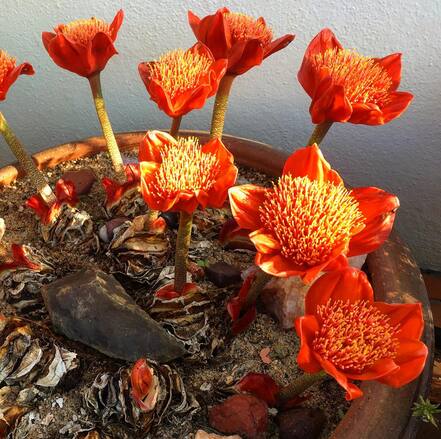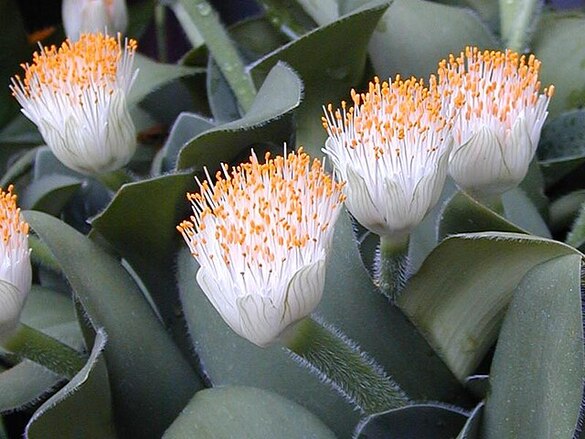Haemanthus canaliculatus, commonly known as the blood lily or red blood lily, is a striking species belonging to the Amaryllidaceae family, native to South Africa. Known for its vibrant red blooms and unique appearance, this plant is a favorite among gardeners and plant enthusiasts. It not only adds a splash of color to landscapes but also embodies resilience and beauty. In this article, we explore the characteristics, cultivation, and care of Haemanthus canaliculatus, along with its cultural significance.
Haemanthus canaliculatus stands out with its dramatic flower head, which is made up of numerous slender, star-like petals that form a ball of fiery red. These blooms are often described as looking like a burst of flame or an explosion of color, making the plant a striking focal point in any garden. The flowers, which appear from late spring to summer, are supported by thick, fleshy stems that give them a regal, elevated look.

In addition to its stunning flowers, Haemanthus canaliculatus has broad, dark green leaves that form a rosette at the base of the plant. These leaves are typically elongated and slightly wavy, providing a contrasting backdrop to the brilliant red flower heads. The combination of bold red flowers and lush green foliage creates a dramatic visual effect.
The plant's bulbous roots store water and nutrients, enabling it to survive in less-than-ideal conditions. This storage capacity is one of the reasons Haemanthus canaliculatus is so well-suited to survive in arid regions.
Haemanthus canaliculatus is native to the dry, rocky regions of South Africa, particularly in the Cape Province. It thrives in the wild in areas with well-drained, sandy soils, often found in rocky outcrops and bushveld. The plant has adapted to the harsh conditions of its native environment by developing water-storing bulbs, which allow it to endure periods of drought.
In its native habitat, Haemanthus canaliculatus experiences distinct seasons, with a wet summer and a dry winter. The plant blooms during the rainy season, taking advantage of the available water. As such, it is well-adapted to periods of low rainfall and high temperatures, which is why it is an excellent choice for water-wise gardening in similar climates.
Growing Haemanthus canaliculatus can be a rewarding experience, but it does require some attention to detail in order to thrive. Below are some tips for successfully cultivating this stunning plant:
Light: Haemanthus canaliculatus requires full sunlight to bloom properly. Choose a location that receives at least 4-6 hours of direct sunlight per day. While the plant can tolerate partial shade, it will not flower as profusely in low light conditions.
Soil: This plant prefers well-drained, slightly acidic to neutral soils. Sandy or loamy soils with good drainage are ideal. Avoid heavy, clayey soils, as they can cause waterlogging, leading to bulb rot. If planting in a pot, ensure the pot has drainage holes to prevent excess moisture buildup.
Watering: Haemanthus canaliculatus is a drought-tolerant plant once established. It requires minimal watering during the dormant period in winter, but during its active growing season in spring and summer, it benefits from occasional watering. Be sure to let the soil dry out between waterings to avoid root rot. Overwatering is the most common cause of failure with this plant.
Temperature: Haemanthus canaliculatus thrives in warm climates. It prefers temperatures ranging from 20°C to 30°C (68°F to 86°F). It is not frost-tolerant, so if you live in a cooler climate, it's best to grow it in containers that can be brought indoors during the winter months.
Fertilizing: Fertilization is not strictly necessary, but a light application of balanced fertilizer once or twice a year can encourage healthy growth. Avoid excessive fertilizing, as this can lead to poor flowering or root damage.
Propagation: Haemanthus canaliculatus is typically propagated through bulb offsets. When the plant has matured, it will produce small bulbs or offsets around the main bulb. These offsets can be carefully separated and replanted in new containers or directly in the garden.
The blood lily has held symbolic meaning in various cultures, often associated with passion, vitality, and energy due to its intense red flowers. In some African cultures, it is seen as a symbol of strength and resilience, reflecting the plant’s ability to thrive in difficult, dry conditions. The blood-red blooms are also linked to life and vitality, a reflection of the plant’s energetic and vibrant nature.
In gardening, Haemanthus canaliculatus is often used as an accent plant in rock gardens, xeriscapes, or as a striking container plant. Its bright red flowers make it a favorite for adding dramatic color and contrast to landscapes.

Haemanthus canaliculatus is generally a hardy plant with few problems. However, like many other plants, it can suffer from certain pests and diseases, including:
Bulb rot: Caused by overwatering or poor drainage, bulb rot is one of the most common issues with this plant. Ensure the soil drains well and avoid overwatering.
Mealybugs and aphids: These pests can occasionally target the plant, particularly the flower stems. If infestations are noticed, they can be treated with insecticidal soap or a mixture of water and dish soap.
Fungal infections: In humid or excessively wet conditions, fungal diseases may develop, leading to yellowing leaves or rot. Proper air circulation and avoiding excessive moisture will help prevent this.

Haemanthus canaliculatus, with its fiery red blooms and striking appearance, is an excellent choice for gardeners looking for a unique and resilient plant. Its low-maintenance nature and vibrant flowers make it an attractive addition to any garden, particularly for those in dry, warm climates. Whether grown in containers, rock gardens, or as an accent plant, the blood lily is sure to be a conversation starter, admired for its beauty and strength. With proper care, this stunning plant will thrive and bring an explosion of color to your landscape for many years to come.
animal tags: haemanthus-canaliculatus
We created this article in conjunction with AI technology, then made sure it was fact-checked and edited by a Animals Top editor.